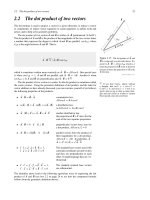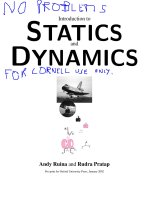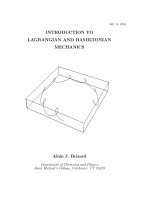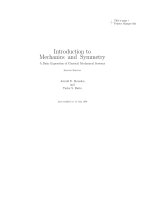- Trang chủ >>
- Khoa Học Tự Nhiên >>
- Vật lý
introduction to polarography and voltammetry
Bạn đang xem bản rút gọn của tài liệu. Xem và tải ngay bản đầy đủ của tài liệu tại đây (1.91 MB, 64 trang )
www.metrohm.com
Introduction to Polarography
and Voltammetry
Univ Prof. Dr. Günter Henze
Monograph
All rights reserved, including that of translation
Printed in Switzerland by Metrohm Ltd., CH-9101 Herisau
8.027.5003 – 2003-08
Introduction to Polarography and Voltammetry 1
Introduction
to
Polarography and Voltammetry
Univ Prof. Dr. Günter Henze
All rights reserved, including that of translation.
Printed in Switzerland by Metrohm Ltd., CH-9101 Herisau
8.027.5003 - 2003-08
2 Introduction to Polarography and Voltammetry
Introduction to Polarography and Voltammetry 3
Table of Contents
Table of Contents 3
1. Terminol ogy 5
2. Direct current methods 7
3.
Pulse methods 11
4. Alternating current methods 17
5. Stripping methods 19
5.1 Anodic stripping voltammetry 20
5.2 Cathodic stripping voltammetry 30
5.3 Adsorptive stripping voltammetry 33
5.4 Stripping chronopotentiometry 43
6. Instrumentation 49
7. Sample preparation 53
8. Table 56
9. Literature 60
4 Introduction to Polarography and Voltammetry
Introduction to Polarography and Voltammetry 5
1. Terminology
Polarography and voltammetry are the names of analytical methods based on current-
potential measurements in electrochemical cells. The analytical signal is the current –
normally a faradaic current – which flows through the cell during the reaction of the analyte
at the working electrode with a small surface. The analyte may be a cation, an anion or a
molecule.
The founder of this method, Jaroslav Heyrovský, introduced the dropping mercury electrode
as the working electrode. The electrode consists of a thick-walled glass capillary from which
the mercury drops into the sample solution under the pressure of a column of mercury. In
his paper Electrolysis with the dropping mercury cathode (1922) he called the recorded
current-potential curves polarograms and introduced the term polarography.
The term voltammetry results from volt-am(père)-metry and should not be confused with
voltametry – written with one m – which is described by IUPAC (International Union of Pure
and Applied Chemistry) as being a controlled-current potentiometric titration.
The terms polarography and voltammetry are frequently used in the reverse sense or are
used inaccurately. According to the IUPAC rules, the term polarography should always be
used when the current-potential curve is recorded by using a liquid working electrode whose
surface can be renewed periodically or continuously (e.g. by drops). This includes the
classical dropping mercury drop electrode (DME) and the subsequently developed static
mercury drop electrode (SMDE – see Section 6).
Voltammetry includes all methods in which the current-potential measurements are made at
stationary and fixed working electrodes (irrespective of their material composition). These
include the hanging mercury drop electrode (HMDE), the thin mercury film electrode (TMFE),
glassy carbon electrodes (GCE) and carbon paste electrodes (CPE). Working electrodes
made of noble metals (e.g. gold or platinum) are used less frequently.
Various methods are assigned to the terms polarography and voltammetry; these differ in
the measuring technique and the type of electric potential used to excite the determination
process.
6 Introduction to Polarography and Voltammetry
Introduction to Polarography and Voltammetry 7
2. Direct current methods
In the simplest case the polarography measuring principle is based on the registration of the
current that flows through the DME as working electrode during a linear (direct) voltage
alteration (classical direct current polarography, DCP). The counter electrode is normally
an electrode of the second kind, e.g. a calomel or silver chloride electrode which, in contrast
to the relationship in modern measuring setups (three-electrode technique, see Section 6), is
at the same time the reference electrode.
On closer observation the current flowing through the working electrode is made up of two
components, the faradaic current i
F
, which is based on the reduction or oxidation of the
analyte, and the capacitive current i
C,
which is caused by the charging and discharging of
the electrochemical double layer on the surface of the working electrode. For most polaro-
graphic determinations the faradaic current provides the measuring signal (useful signal)
and the capacitive current the unwanted interference components (interference signal). This
relationship is shown in Fig. 1.
Under practical conditions the potential-dependent capacitive current can grow up to 10
-7
A
and is then within the range of the faradaic diffusion current i
D
of an analyte solution with
10
-5
mol/L. If i
C
has the same value as i
F
(i
F
/i
C
= 1), then the useful signal can no longer be
separated from the interference signal; i.e. the detection limit for direct current polarographic
determinations is limited by the relationship between the useful signal and interference sig-
nal (also known as the signal-noise ratio).
– E
i
i
C
i
F
i
D
F
ig. 1: Relationship between the faradaic current i
F
and capacitive current i
c
in a
direct current polarogram; i
D
is the diffusion current.
8 Introduction to Polarography and Voltammetry
The diffusion current i
D
is the maximum value for i
F
which is obtained when all the analyte
particles transported to the surface of the mercury drop by diffusion have been converted,
i.e. reduced or oxidized (charge-transfer reaction). The relationship between the diffusion
current and the analyte concentration is described by the Ilkovič equation.
Polarographic determinations with a higher sensitivity are only possible if the ratio i
F
/i
C
can be
improved by other measuring techniques (by increasing i
F
or reducing i
C
). Considerations
concerning the (partial) elimination of the capacitive current led to sampled DC polaro-
graphy
1
and to the pulse methods. Attempts to increase the faradaic current resulted in
stripping voltammetry, in which the analyte is accumulated electrolytically at a stationary
working electrode before its voltammetric determination. In addition, the performance of
both polarographic and voltammetric methods has been improved by the introduction of
digital instruments and the use of a static mercury drop electrode (SMDE) instead of the
dropping mercury electrode (DME) – (see Instrumentation, Section 6).
In digital instruments the direct current polarograms are no longer recorded with a linear
potential alteration, but by using a staircase ramp as the excitation signal. In the measuring
technique shown in Fig. 2 the current in the measuring time t
m
is always measured at the end
of a potential step (the potential ramp is synchronized with the drop life at the SMDE), i.e. at
a constant potential (part b) and at an electrode surface area that remains constant (part a);
this reduces the contribution of the capacitive current to the measuring signal to a minimum.
1
When the current is sampled at the end of a drop life, then i
C
is at its smallest in comparison to i
F
, as during the
dropping time the diffusion current increases with t
1/6
, whereas the capacitive current decreases with t
-1/3
.
Ilkovič equation
adD
ctmDni ⋅⋅⋅⋅⋅=
6
1
3
2
2
1
607,0
(Eq. 1)
i
D
Diffusion current
n Number of electrons exchanged in the charge-transfer reaction
D Diffusion coefficient of the analyte
m Mercury flow rate
t
d
Dropping time of the mercury drop
c
a
Concentration of the analyte
Introduction to Polarography and Voltammetry 9
This method is known as sampled DC polarography; in comparison to classical DC polaro-
graphy it produces smooth (oscillation-free) polarograms (part c) and, because of the re-
duction of the capacitive current contribution to the measuring signal, is more sensitive by
about one order of magnitude.
A
E
a
(Surface szie of
the Hg-drop)
t
t
m
b
∆ E
step
t
step
t
i
c
– E
E
1
/
2
Drop
life time
Start
potential
F
ig. 2: Measuring technique of sampled DC polarography
a
Drop growth (SMDE); b Excitation signal (staircase ramp); c
P
olarogram; t
step
Duration of a current step = drop life;
t
m
Measuring time;
∆
E
step
Current step
10 Introduction to Polarography and Voltammetry
Introduction to Polarography and Voltammetry 11
3. Pulse methods
The pulse methods include square-wave polarography, normal pulse polarography and
differential pulse polarography.
A general feature of these methods is that the electrode processes are excited in different
ways with periodically changing square wave potentials at a constant or increasing ampli-
tude
∆
E
A
. In this way it appears that during the pulse time the faradaic current i
F
decreases
with t
-½
and the capacitive current i
C
with e
-kt
(see Eq. 2).
2
As a result, in a measurement to-
ward the end of the pulse time t
P
it is chiefly the faradaic contribution which is recorded, as
at this time the capacitive current has almost completely vanished (see Fig. 3).
The methods developed with square wave potential pulses differ in the frequency and height
(amplitude) of the applied pulses as well as in the formation principle of the measured value.
All methods can be carried out polarographically with the static mercury drop electrode or
voltammetrically with stationary mercury electrodes or with solid-state electrodes.
2
Eq. 2 corresponds to the equation for a capacitor with discharge resistance R and double layer capacity C
D
t
p
∆E
A
i
F
i
C
t
t
F
ig. 3: Principle of the pulse methods
Reduction of the capacitive current
during the pulse time
D
CR
t
A
C
e
R
E
i
⋅
−
⋅
∆
=
(Eq. 2)
i
C
Capacitive current
∆
E
A
Pulse amplitude
R Discharge resistance
t Time after pulse application
C
D
Double layer capacity of working
electrode
12 Introduction to Polarography and Voltammetry
The square wave polarography (SWP) introduced by Barker and Jenkins 1952 is based on
the fact that a linearly increasing direct potential has a square wave alternating potential of a
constant size (square wave potential amplitude ∆E
A
up to 50 mV) and frequency (usually
125 Hz) superimposed on it. In digital instruments a staircase-shaped potential increase is
applied instead of the linearly increasing basic potential. Each potential step (ramp) has su-
perimposed either one po-
tential pulse or several (up
to 250) square potential
cycles (oscillation fre-
quency f) with defined and
constant pulse amplitudes.
In addition, modern instru-
ments are equipped with a
static mercury drop elec-
trode, which ensures that
the measurements are not
only made at a constant
potential, but also with a
constant electrode
surface area.
In the measuring tech-
nique shown in Fig. 4 two
current values are meas-
ured at each oscillation: i
+
at the positive pulse end
(measuring point 1) and i
–
at the negative pulse end
(measuring point 2). When
the difference between the
two current values i
+
– i
–
determined for a potential
ramp is plotted against the
particular potential then a
peak-shaped polarogram
is obtained with the peak
potential E
P
and the peak
current i
P
(see Eq. 3)
For
reversible processes E
P
corresponds to the direct
current polarographic half-
wave potential E
½
.
– E
E
p
Measuring point 2
Measuring
point 1
i
Start
potential
f
Drop life time
(Surface szie of
the Hg-drop)
A
t
m
c
t
t
Measuring
cycles
∆ E
A
b
a
E
∆ E
step
t
step
F
ig. 4: Measuring technique of square wave polarography
a
Drop growth (SMDE); b Excitation signal; c Polarogram;
∆
E
step
Potential step for staircase ramp (up to 2-12 mV); t
step
Duration
of a potential step (0.5-10 s);
∆
E
A
Square wave potential amplitude
(~ 25 mV); t
m
Measuring time; f Oscillation frequency (approx. 125 Hz
f
or t = 40 ms)
Introduction to Polarography and Voltammetry 13
The height and half-width b
½
of a peak (b
½
is at i = i
P
/2) depend on the electron exchange n
of the charge-transfer reaction and the height of the superimposed square wave pulses (for
a small ∆E
A
then b
½
= 90/n mV).
With
∆
E
A
= const. the peak current i
P
increases as the square of the number n of the ex-
changed electrons and also when, at a given electron exchange n, the square wave potential
amplitude is increased. The larger the value of n, the narrower the peaks. However, this rela-
tionship only applies to reversible processes. This is why the sensitivity of square wave
polarographic determinations is at its greatest when the charge-transfer reaction (with a
large n) takes place reversibly, and when the measurements are carried out with a large
pulse amplitude. Under such conditions the detection limit is approx. 10
-8
mol/L.
The method of working known as square wave voltammetry (SWV) according to Oster-
young is characterized by the fact that the whole measuring procedure takes place at a
single mercury drop with rapid potential sweeps. The duration of a potential step is identical
with the length of the square wave pulse and is 5-10 ms; i.e. to each potential step only one
square wave potential cycle with a relatively large amplitude of ∆E
A
= 50 mV is added; this
is shown in Fig. 5.
The difference in the measured values obtained in points 1 and 2 (at very short measuring
times) is plotted against the potential and, as in the case of square wave polarography, re-
sults in a bell-shaped current-potential curve.
The pulse times in the ms-range (frequencies up to 250 Hz) allow speeds for the potential
sweeps of up to 1000 mV·s
-1
, whereas only a single mercury drop is required for each
individual measuring procedure. Under these conditions interfering signals from irreversible
reactions (e.g. the signal produced by oxygen reduction) can be eliminated and rapid
measurement in flowing media can be carried out on a single mercury drop (flow-through
voltammetry).
Peak current in a square wave polarogram
aAP
cEDnki ⋅∆⋅⋅⋅=
2
1
2
(Eq. 3)
i
P
Peak current
k Constant
n No. of exchanged electrons in the charge-transfer reaction
D Diffusion coefficient of the analyte
∆E
A
Pulse amplitude
c
a
Concentration of the analyte
14 Introduction to Polarography and Voltammetry
In normal pulse polarography (NPP) the potential is not altered by a continuously
increasing potential ramp, but by square wave potential pulses with increasing height (pulse
amplitude ∆E
A
), overlaid on a constant initial potential. The superimposing of the pulse is
synchronized with the drop formation, with each drop having a single potential pulse with a
pulse time of about 50 ms applied to it. The amplitude increases from one drop to the next
by a constant amount and achieves a maximum of 1000 mV. The current is measured at the
end of the drop life about 10 to 15 ms before the expiration of the pulse time t
P
. As potential
alteration at each drop is relatively large and the pulse time very short, a large concentration
gradient is produced and, as a result, a large faradaic current. In contrast, the capacitive
current remains small, as the measurement is made with the surface of the mercury drop
remaining constant and i
C
has practically vanished at the time that the measurement is
made. The measured current is recorded or stored until the next measurement (on the fol-
lowing drop). If the individual current values are plotted against the potential alteration of the
pulse then step-shaped current-potential curves are obtained. The curves are peak-shaped if
the current of each preceding pulse is subtracted from the stored measured value of the fol-
lowing one. The sensitivity that can be achieved is approx. 10
-7
mol/L; the resolution is given
as ~100 mV. Fig. 6A shows the excitation signal and current-potential curve for NPP.
The most efficient pulse method is differential pulse polarography (DPP). In digital instru-
ments the excitation signal consists of a staircase-shaped increasing direct potential (poten-
tial step ∆E
step
), to which small square wave pulses with a constant potential (pulse ampli-
tude ∆E
A
) are applied in periodic succession. The superimposition is synchronized with the
drop time and takes place when the electrode surface no longer changes. Fig. 6B shows the
DPP measuring technique and the polarographic curves.
Measuring point 2
Measuring point 1
t
step
∆ E
A
∆ E
step
F
ig. 5: Measuring technique of square wave vol
t
ammetry acc. to Osteryoung
t
step
Duration of a potential step or a square wave pulse (10 ms);
∆
E
A
Square
wave potential amplitude (20 mV);
∆
E
step
Potential step of the staircase ramp
(4 mV)
Introduction to Polarography and Voltammetry 15
t
E
E
i
∆E
A
i
D
E
1
/
2
i
D
E
P
∆i = i
2
-
i
1
2
1
∆E
A
t
P
∆E
step
t
step
A
B
t
E
E
i
∆E
A
i
D
E
1
/
2
i
D
E
P
∆i = i
2
-
i
1
2
1
∆E
A
t
P
∆E
step
t
step
t
E
E
i
∆E
A
i
D
E
1
/
2
i
D
E
P
∆i = i
2
-
i
1
2
1
∆E
A
t
P
∆E
step
t
step
A
B
F
ig. 6: Excitation signals and curren
t
-potential curves for normal pulse
p
olarography (A) and differential pulse polarography (B).
The current is measured twice at each mercury drop, before each pulse and at the end of the
pulse time t
P
. The difference between the measurements (∆i) is plotted against the direct
potential and produces peak-shaped polarograms, as ∆i is largest for potential alterations in
the region of the half-wave potential. The formation of this difference also leads to a further
reduction of the capacitive current contribution and therefore to an increase in sensitivity,
even when compared with determinations by normal pulse polarography.
According to Eq. 4, for reversible electrode processes the peak height i
P
in the DP polaro-
grams is proportional to the analyte concentration c
a
and is determined by the amplitude
∆
E
A
of the square wave pulses as well as by the pulse time t
P
, among other factors.
16 Introduction to Polarography and Voltammetry
The detection limit for determinations by differential pulse polarography is similar to that for
square wave polarography at about 10
-7
-10
-8
mol/L; however, the decrease in sensitivity re-
sulting from irreversibility is lower.
Peak current in a differential pulse polarogram
P
AaP
t
D
EcA
RT
Fn
i
π
∆⋅⋅=
4
22
(Eq. 4)
i
P
Peak current
n No. of exchanged electrons in charge-transfer reaction
F Faraday constant
R Gas constant
T Absolute temperature
A Electrode surface area
c
a
Concentration of the analyte
∆
E
A
Pulse amplitude
D Diffusion coefficient of the analyte
t
P
Pulse duration
Introduction to Polarography and Voltammetry 17
4. Alternating current methods
In the alternating current polarography (ACP) introduced by Breyer in 1952 a linear or
staircase-shaped direct potential (E
=
) is modulated by a sinusodial voltage (E
~
) with a small
amplitude (∆E
A
= 5-20 mV). This produces an alternating current i
∼
, whose size is deter-
mined by the direct potential E
=
currently applied and which is greatest at the half-wave
potential. As shown in Fig. 7, by plotting the selectively measured alternating current against
the direct potential a peak-shaped alternating current polarogram is obtained.
For reversible processes and with a small alternating voltage amplitude E
P
= E
½
. In addition,
according to Eq. 5, under these conditions the peak current is proportional to the concentra-
tion and depends on the frequency f of the superimposed AC voltage.
The dependency of the AC polarographic peak currents on the kinetics of the charge-transfer
reaction is so marked that the signals of strongly irreversible processes can be suppressed.
For reversible processes the half-width of the peak after b
½
= 90/n (mV) depends on the
electron exchange; therefore the larger n is, the narrower is b
½
. This statement only applies
to reversible processes, as slow processes broaden the peak.
Because of the high capacitive current contribution, which is mainly caused by the periodic
charging and discharging of the double layer, alternating current polarographic determina-
tions are limited to a sensitivity of about 10
-5
mol/L. For reversible redox processes the sen-
sitivity can be improved to about 5·10
-7
mol/L, if the alternating current is measured at a par-
ticular phase shift with reference to the excitation signal in order to separate the faradaic and
capacitive current (AC1 polarography).
Peak current in an alternating current polarogram
()
RT
E
DfAFnci
A
aP
4
2
~
2
1
22
~
∆
⋅⋅⋅⋅⋅⋅⋅=
π
(Eq. 5)
i
P~
Peak current
c
a
Concentration of the analyte
n No. of exchanged electrons in the charge-transfer reaction
F Faraday constant
A Electrode surface area
f AC voltage frequency
D Diffusion coefficient of the analyte
∆E
A
∼
Amplitude of the superimposed AC voltage
R Gas constant
T Absolute temperature
18 Introduction to Polarography and Voltammetry
The measurement of the harmonics of the alternating current resulting from the non-linearity
of the faradaic resistance, e.g. the 2nd harmonic, with the aid of phase-selective rectification
(AC2 polarography) again reduces the capacitive current contribution. In this way not only a
further increase in sensitivity is achieved, but also the selectivity of the determinations is
improved.
The polarographic instruments from Metrohm Ltd. are equipped with a selectable phase
angle and allow both peak-shaped AC1 and sine-shaped AC2 polarograms to be recorded.
i
– E
=
i
~
∆ E
A
~
E
1
/
2
i
~
i
~
b
1
/
2
E
p~
– E
=
∆ E
A~
F
ig. 7: Principle of alternating current polarography.
∆
E
A
∼
Amplitude of the superimposed alternating voltage; i
∼
A
lternating current; E
P
∼
Alternating current peak; b
½
Half-
width of peak
Introduction to Polarography and Voltammetry 19
5. Stripping methods
Stripping voltammetry methods are the most efficient electrochemical techniques for trace
analysis and species analysis. The unusually high sensitivity and selectivity are based on the
fact that the analyte is accumulated before it is determined (composite method) and that
both accumulation and determination are electrochemical processes whose progress can be
controlled.
In comparison to conventional polarographic work, determinations by stripping voltammetry
are generally more sensitive by a factor of 10
3
to 10
5
, so that the detection limits are
between 10
-9
to 10
-11
mol/L and in some cases even 10
-12
mol/L. This means that stripping
methods are among the most sensitive instrumental analysis methods of all; they are also
superior to other trace analysis techniques as regards the correctness of the measured
values obtained. As both accumulation and the determination take place at the same elec-
trode without needing to change vessels this means that the occurrence of systematic errors
by contamination or evaporation can be kept at a very low level.
The term stripping stands for the fact that during the determination the accumulated product
is removed from the working electrode. This process can be followed voltammetrically or
chronopotentiometrically
3
, this is expressed by the terms stripping voltammetry and
stripping chronopotentiometry.
Accumulation always takes place at constant potential (E
acc
, accumulation potential) at a
stationary mercury drop, mercury film, graphite or noble metal electrode and for a controlled
period (t
acc
, accumulation time). The analyte is deposited electrolytically as a metal, as a
sparingly soluble mercury compound or adsorptively as a complex compound. The removal
of the accumulated analyte species from the working electrode – the real determination step
– is based on an oxidation or reduction process. In the classical case where the analyte is
accumulated at the mercury drop or mercury film electrode as an amalgam the determina-
tion is the reverse process to accumulation, which is where the name inverse voltammetry
originated from.
3
Chronopotentiometry, see Section 5.4
Mechanism for anodic stripping voltammetry
Me
n+
+ n e
−
+ (Hg) Me°(Hg)
Determination (anodic)
Deposition (cathodic)
20 Introduction to Polarography and Voltammetry
In order to differentiate this method from other methods in which the determination does not
take place by oxidation, but by reduction of the accumulated product, the term anodic strip-
ping voltammetry (ASV) is used. In the other cases the method is known as cathodic strip-
ping voltammetry (CSV). With adsorptive accumulation of the analyte the method is known
as adsorptive stripping voltammetry (AdSV).
5.1 Anodic stripping voltammetry
Anodic stripping voltammetry (ASV) can be used to determine all metals which are soluble
in mercury with the formation of amalgams or which can be deposited electrolytically at car-
bon or noble metal electrodes. The steps in an ASV determination are shown in Fig. 8.
Section a is the accumulation time, in which the analyte is deposited at the working elec-
trode at a constant potential and with the sample solution being stirred continuously. As
deposition is always incomplete, the working conditions must be strictly controlled if repro-
ducible measurements are to be achieved. These include the accumulation time, accumula-
tion potential, the shape, size and arrangement of the stirrer, the stirring speed (rotation), the
sample volume and the surface area of the electrode (surface of the mercury drop or film).
Section b is the rest period. During this period the sample solution is no longer stirred, this
means that the cathodic current drops because of lack of convection. As small amounts of
the analyte are deposited even from an unstirred solution, this period must also be con-
trolled. Several seconds pass before the solution comes to a standstill and the deposited
metal is well distributed in the mercury drop. This is why the rest period is defined as being
5 s to a maximum of 30 s. In a mercury film the distribution process is complete after only a
few seconds. Section c in Fig. 8 is defined by the potential scan rate (∆E/∆t = const.),
which is the rate at which the anodic stripping voltammogram is recorded. The measuring
signal is the peak current i
P
, which in Section d changes into the anodic current for the
dissolution of the electrode mercury.
Introduction to Polarography and Voltammetry 21
a cd
b
i
(-)
i
(+)
time
i
P
E
(-)
∆E
/
∆t
E
P
time
E
acc
with
stirring
without
stirring
F
ig. 8: Method steps and current-potential curve for determinations by
a
nodic stripping voltammetry
E
acc
= Accumulation potential;
∆
E/
∆
t Potential scan rate; E
P
Peak
p
otential; i
P
Current peak; a Accumulation time; b Rest period; c
D
etermination step; d Anodic dissolution of the electrode mercury
22 Introduction to Polarography and Voltammetry
According to Eq. 6, the accumulation, i.e. the amount of metal cathodically deposited or the
concentration of the metal in the amalgam, depends on the electrolysis current, the accu-
mulation duration and the volume of the mercury drop or mercury film.
The electrolysis current i
acc
is determined by the transport of the analyte and the potential at
which accumulation takes place. For high accumulation rates the solution should be stirred
and the accumulation potential should be in the diffusion current range. The direct current
polarograms or the half-wave or peak potentials can be used as guidelines for this. As a rule
of thumb it can be said that the accumulation potential should be about 200-400 mV more
negative than the polarographic half-wave potential.
The transport of the analyte to the electrode surface takes place by diffusion and is sup-
ported by convection if the solution is stirred during accumulation. This means that the elec-
trolysis current i
acc
not only depends on the diffusion conditions, but also on the hydro-
dynamic conditions which are based on laminar or turbulent flow (at high stirring speeds or
when working with a rotating electrode). At a constant stirring speed or number of revo-
lutions the amount of metal deposited at the cathode is proportional to both the accumula-
tion time and the analyte concentration in the sample solution.
Amount of cathodically accumulated metal in the amalgam
FnV
ti
c
Hg
accacc
HgMe
⋅⋅
⋅
=
° )(
(Eq. 6)
c
Me°(Hg)
Concentration of the metal (accumulated analyte) in the
amalgam
i
acc
Electrolysis current during accumulation
t
acc
Accumulation time
n Electron transfer during reduction of the analyte
F Faraday constant
V
Hg
Volume of the hanging
mercury drop
3
3
4
rV
Hg
⋅⋅=
π
or the mercury film
ϑ
⋅=
FHg
AV
r Radius of the mercury drop
A
F
Surface area of the mercury film
ϑ
Thickness of the mercury film
Introduction to Polarography and Voltammetry 23
The accumulation time depends on the concentration of the analyte in the sample solution
and must be chosen in a way that the measuring signal remains linear throughout as large a
concentration range as possible. Deposition is never fully complete; at voltammetric working
electrodes this could in any case only be achieved with very small samples volumes (< 0.1
mL) and long electrolysis times. Under normal working conditions with 5 to 20 mL sample
solution and about 1 min accumulation at a mercury drop with a surface area of a few mm
2
only a few tenths of a percent are deposited.
In ASV the determination is based on the anodic dissolution of the accumulated analyte.
This process is followed voltammetrically and produces a current peak which, when the
HMDE is used, is proportional to the potential scan rate and the radius of the mercury drop
r
2
(Eq. 7) .
Peak current in an anodic stripping voltammogram using a
HMDE
accHgMe
HgMe
p
trcDnki ⋅⋅⋅⋅⋅⋅=
°
°
2
2
1
)(
2
1
)(
2
3
ν
(Eq. 7)
i
P
Peak current
k Constant
n Electron transfer during oxidation of the analyte
2
1
)(HgMe
D
°
Diffusion coefficient of the metal deposited in the
amalgam
c
Me°(Hg)
Concentration of the metal (accumulated analyte) in the
amalgam
ν
Scan rate
r Radius of mercury drop
t
acc
Accumulation time
24 Introduction to Polarography and Voltammetry
Eq. 8 applies for the peak current obtained with the TMFE; it can be seen that the peak
current is proportional to the scan rate and surface area A
F
of the mercury film.
In both cases the peak current depends on the accumulation time t
acc
and is therefore also
proportional to the concentration of the analyte c
Me
o
(Hg)
in the amalgam and indirectly propor-
tional to the concentration of the analyte in the sample solution.
In general, in ASV determinations with mercury film electrodes higher sensitivities are to be
expected than with mercury drop electrodes. In addition the peaks are narrower, so that
neighboring peaks are separated better. The reason for this is the different geometric struc-
tures of the two electrodes. As the film electrode normally has a larger surface area, the
mass transfer is larger at the film than at the drop for the same accumulation rate.
A decisive factor for the sensitivity of voltammetric determinations is not only the size of the
electrode surface, but also the attempt by the deposited metal to distribute itself uniformly in
the mercury. This means that higher metal concentrations occur at the surface of the film
than at the drop surface.
Measurements with mercury film electrodes produce higher signal currents and narrower
peak shapes, but also have relatively high background currents. Similarly good results (with
lower background currents) can also be achieved with the drop electrode, if the voltammo-
gram is recorded at a slow scan rate and with very small drops (e.g. with the multi-mode
electrode from Metrohm Ltd., see Fig. 19). The advantage of a small mercury drop is (simi-
lar to the film) the relatively small diffusion area, from which during anodic dissolution the
analyte can diffuse very rapidly to the surface for exchange. As the mercury drop is easy to
handle and can be renewed reproducibly by dropping (tapping), the mercury drop electrode
is used more frequently in practice than the mercury film electrode.
Peak current in an anodic stripping voltammogram using the
TMFE
)(
2
HgMeaccFp
ctAnki
°
⋅⋅⋅⋅⋅=
ν
(Eq. 8)
i
P
Peak current
k Constant
n Electron transfer during the oxidation of the analyte
A
F
Surface area of mercury film
ν
Scan rate
t
acc
Accumulation time
c
Me°(Hg)
Concentration of metal (accumulated analyte) in the
amalgam









